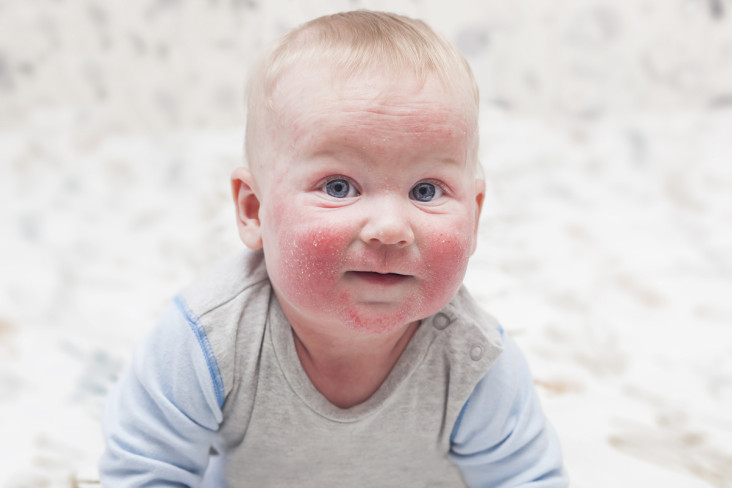Atopic dermatitis is cured by natural therapy

Pathologic features of atopic dermatitis
Typical symptoms of atopic dermatitis are itching and swelling of the whole body and dryness or irritation of the skin. Scraping skin by scratching the area makes it easier to become infected. Most atopic dermatitis patients have a food allergy which can cause asthma and hay fever also.
Atopic dermatitis and allergy
The first thing that you can do is to know which foods you are allergic to, so you can avoid those foods. Breastfeeding is also a great way to prevent and treat atopic dermatitis as well as other diseases.
If your baby shows atopic dermatitis symptoms when you are breastfeeding, you’d better stop eating food that can easily cause allergy such as dairy foods, eggs, peanuts, wheat flour, soy beans, citrus fruits, and chocolate, though each person is allergic to different food. By avoiding these types of food, your baby’s atopic dermatitis will be cured by breastfeeding most of the time. One research study shows that formula, cow’s milk, eggs, and peanuts have an 80% chance of causing atopic dermatitis. For effective treatment to control the allergy, I use homeopathy. In this case, the therapy is more like an emergency treatment, and it is very useful in the control of allergic reaction. I use Histaminum for allergic reactions in general, Urtica for rashes such as hives, and Apis for red blister-like symptoms.
Atopic dermatitis symptoms will be largely improved if you avoid any food additives or artificial preservatives in addition to those foods listed above. You can also find out specific foods that you are allergic to with a simple blood test.
Connection of atopic dermatitis and intestinal bacteria
In addition, the overgrowth of Candida yeast and malignant bacteria in the gastrointestinal tract is also known to have a strong connection with allergies, including atopic dermatitis. This overgrowth of Candida and malignant bacteria is mainly caused by intensive use of antibiotics. Improving the balance of the bacteria in the GI tract is an effective treatment to reduce allergy symptoms. For this, probiotics such as lactobacillus bifidobacteria are useful.
Omega-3 and omega-6
Which nutrient is good for treating atopic dermatitis? The most effective nutrients are omega-3 fatty acids and omega-6 fatty acids. Omega-3 fatty acids turn into a chemical substance in the body that reduces inflammation. Omega-3 fatty acids, known as EPA and DHA, are mainly contained in fish. And by taking together with zinc, omega-3 fatty acids can turn into a chemical substance which efficiently suppresses inflammation. However, the balance between omega-6 and omega-3 is crucial; when omega-6 is insufficient, your skin will get very sensitive, dry, and difficult to cure. There are 3 types of omega-6. The arachidonic acid causes a tendency to increase inflammation, Gamma-linolenic acid(GLA) and alpha linoleic acid (ALA) are used to reduce and inflammation. Gamma-linolenic acid (GLA, in particular, is good for treating atopic dermatitis because it prevents dryness of the skin and reduces inflammation. Gamma-linolenic acid is contained in evening primrose oil. In a study, the ratio of omega-3 and omega-6 is 1:4 which is the most preferred ratio.
Since arachidonic acid is mainly contained in meat or dairy food such as beef, pork, chicken, eggs, and milk, you should limit the intake of them. As I mentioned, arachidonic acid can easily cause inflammation, and sugar and gluten containing food also make inflammation worse. So you need to make sure that your kids not eating too much sugar or flour products. They could add fuel to the fire.
Prevention of histamine
Licorice, ginkgo leaf, blueberry, green tea, and grape seeds are great foods to prevent the release of histamine, the allergic substance. Coleus forskohlii (herb native to India) and quercetin and hesperidin (bioflavonoids) are also known as the most effective food to prevent histamine reactions. Taking such foods or supplements regularly is highly recommended to prevent inflammation and allergic reaction.
Atopic dermatitis and detox
Eliminating toxins from your body is a very important step in the treatment of atopic dermatitis. There are various ways to detox. Though the detoxing range is different depending on your age, the most important thing is not to take any more toxins into your body. In particular, pesticides, herbicides, food additives, and artificial preservatives have properties that dissolve in oils and fats, and they tend to remain in your body once eaten, and the get absorbed in fat cells.
I strongly recommend eating organic vegetables as much as possible instead of processed or packaged food or supermarket deli foods. It is possible to hasten the healing process by incorporating the following detox program. Far-infrared saunas enhance the discharge of toxins accumulated in fat. Lymph drainage to promote the flow of lymph glands. Castor oil packs to increase the liver detoxification function, and herbs to enhance the liver function.
Anti-itch
Once you start scratching, the skin gets more itchy and thickens. This happens to many babies. Make sure your baby’s nails are short enough or cover their hands with mittens so they do not scratch their skin, in order to prevent infection. You can also control the itch by applying some calendula cream directly to the skin. In addition, wipe your baby’s sweat off frequently to keep the area clean. Use jojoba oil or borage oil on the affected dry area, since dry skin can easily cause itch.
Atopic dermatitis and stress
Irritation, short temper, and negative emotions, as well as stress, are factors known to worsen atopic dermatitis. Atopic dermatitis patients tend to become anxious and have nervous breakdown, so controlling stress is another important element for treating atopic dermatitis.

